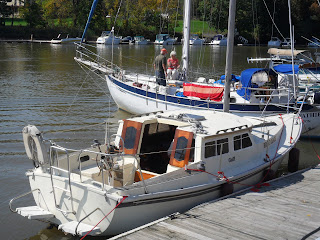Friday was a workday for us. To make the journey up or down the Erie Canal, all sailboats of any size must have their masts removed. The bridges and lift gates on the canal are just too low to allow anything except a small daysailer to pass under them safely. We had checked references on the web when planning our trip, and there seemed to be a consensus that Mike at Riverview Marine Services in Catskill was the guy with the equipment and know-how to get the job done. When we called on Thursday afternoon to set up transient dockage, he advised us to pull up to his fuel dock for the night. We woke to a bright clear morning with perfect weather for the job ahead.
One of the reasons that we chose Broad Reach was the fact that her mast is stepped onto the top of the deck, making the removal job easier than if it were attached to the keel. We knew when we bought her that we would one day take her north to explore the canals in NY and Canada. Before leaving Maryland, we built a system of crutches and stays that could support the mast in a horizontal position above the deck. We built the crutch system high enough so that we could stand at the helm underneath the top of the mast while the mast base sat just a few feet over the bow. We needed to be able to easily move from one side of the deck to the other while guiding the boat into and out of the lock basins. We measured the length of each wire stay as closely as possible, but we were not able to get exact lengths while the mast was still vertical on the boat. We needed the stays to be within 6" of their final length, within the maximum adjustment length of each turnbuckle, so the stays had been constructed with one working end loose. We hoped that the little tiny wire rope clamps on that adjustable working end would hold up under the stresses of the weight and momentum of the mast above the deck, but the system had never been tested or used by us before.
Mike and the folks at Riverview were as good as their advance press. He had a full load of south bound boats that were being restepped after coming down the canal from Canada and the Great Lakes. It took us a few hours to pull off the sails, remove the boom, and get the boat prepped for the final act. Mike fit us into the rotation of boats being worked as soon as we were ready to go under the crane. Here is what she looked like before we went to work with the crane.
Mike and crew got a line set under the spreaders to take the weight of the mast off the deckplate. He wanted the backstay taken off first, so I had to balance with one foot on the sternrail and one foot on the binnacle, and stretch out with my full length, to reach that turnbuckle at the top of the inverted V where the two split stays meet. Once the shrouds were released from each side and the clevis at the base of the forestay was pulled, the crane lifted the mast up off the deck complete with furler and rigging.
I needed time to set the crutch supports before the mast could be laid down horizontal, so Mike shut down the crane, and broke his team for lunch. I worked frantically with all the tiny wire rope clamps to get the bow and stern crutches set. When they came back from lunch, we discovered a small logistical error. In building the crutches, I had cut the tops to fit the smooth U-shape of the front of the mast. The crutches did not have a notch to fit the sailtrack on the aft profile of the mast. We needed to turn the mast 180 degrees from how the crane was holding it. A few southbound Canadians volunteered, and we used the spreaders to turn the mast, ever so slowly, as we eased it down into place. I was at the bow. Mike kept shouting to me repeatedly above the noise of the crane "Whatever you do, don't let go of the base of this thing." She came down and spun around, and fit into the crutches just as nicely as possible.
Mike needed the crane for the next boat on his schedule, and we walked the boat around to the next slip. We fitted the other two crutches, tightened the turnbuckles on the untested system, and called it done. It took another few hours to straighten and secure the furler and standing rigging into the crutches. The last step was to sling the boom under the mast on top of the doghouse.
It was getting on towards dusk when I remembered the problem with the helm from the previous day. I slipped on my trunks and went for a cold dip off the stern. A visual inspection of the rudder just wasn't possible, so I dove under the back of the boat and did my own impersonation of a raccoon, seeing the rudder with my hands through the water. Everything checked out OK. After a quick shower, Niki and I headed off to a cold drink and a hot meal back at Frank Guido's Ports of Call, satisfied that our mast was secured to the deck.







No comments:
Post a Comment